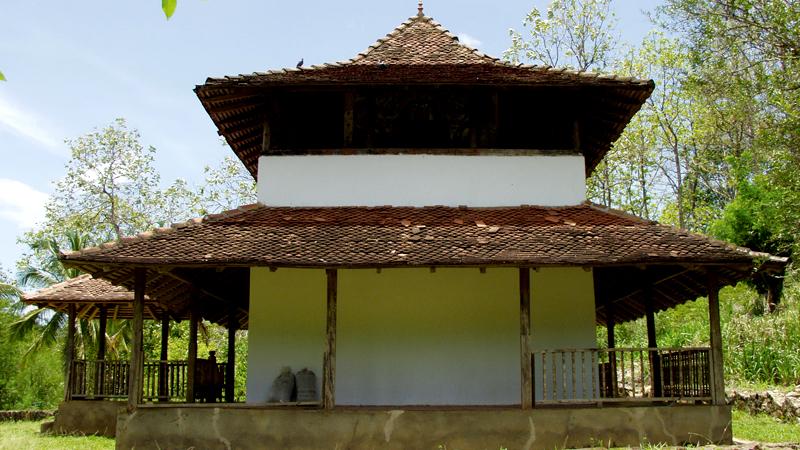
Kandyan murals were created during the Kingdom of Kandy (1469-1815) in Sri Lanka, a time when kings gave a special place to art and literature. With the beginning of the Kandyan Kingdom the bhikkhus got ‘Upasampada’, by which a novice becomes a bhikkhu and started to teach people Buddhism.
 As the people were illiterate, the bhikkhus advised the kings to paint the walls of the temples with ‘Jathaka’ stories so that anyone could understand. That was the beginning of the murals of the Kandyan era.
As the people were illiterate, the bhikkhus advised the kings to paint the walls of the temples with ‘Jathaka’ stories so that anyone could understand. That was the beginning of the murals of the Kandyan era.
The walls of the temples in the Kandyan era were built with clay stuck in between sticks. They then used Makulu Mati, a white coloured clay, to smoothen the walls as temples were allowed to be built only in white colour at that time.
Jathaka stories and episodes of Gautama Buddha’s life were the main themes of Kandyan murals. The renowned artists who drew Kandyan art of that period were Dewragampola Silvatthana and Nilagama Naide whose paintings have adorned the walls of temples such as Degaldoruwa Raja Maha Vihara, Medawala Tempita Vihara and Lewalla Gangarama Viharaya in Kandy.
Kandyan mural
As the whole country was ruled by the Kingdom of Kandy, the influence of Kandyan murals was distributed throughout the country. Thereafter, with the arrival of the Portuguese, the Dutch and the British, European art influenced the Kandyan murals. As the Portuguese and the Dutch ruled only the coastal areas, this influence can be seen largely in coastal areas than in the upcountry. According to these changes, Kandyan murals can be divided into up country era murals and low country era murals.
We found a rare art repository at the Tampita Vihara with Kanyan murals and architecture. It is hidden in the greenery close to Panamura in the Sabaragamuwa Province. The historic Walalgoda Tampita Vihara nestles in a sleepy village in Walalgoda, with the awe-inspiring mountain frontier of Kolonna valley as its backdrop. Sadly, the villagers do not seem to understand the value of the temple as it was in a dilapidated condition when we visited it recently.
Elephant kraal
To reach the Vihara, turn right at the Udagama junction on the Embilipitiya- Ratnapura highway and take the hilly Urubokka-Middeniya road via Panamura, famous for elephant kraal and the tragic tale of the brave elephant leader. Ten kilometres down the road is the Walalgoda junction, with a couple of tea boutiques. A narrow road that branches off to the right from the junction indicates the road to the Vihara.
Sadly, it isn’t history or heritage that attract people to the village of Panamura but the elephant kraal. Walalgoda was one of the administrative villages of Kolonna. The Walalgoda Vihara is structured in the style of the Tampita Vihara, which occupied a unique place among the temples of Sri Lanka during the Kandyan period.
A salient feature of this style is the stone pillars which function as the modern day columns for storeyed buildings. In this instance, it provides the high foundation for the wooden platform that holds the rectangular clay structure.
The Walalgoda Tampita Vihara consists of two platforms, one above the other with wooden frame structures filled with boiled clay, an old method used to protect the material from rain.
The significance of this historic site is in the fact that the walls of both the upper and lower platforms contain unique and rare Kandyan period murals.

The upper floor, which contains the shrine room, can be reached via a short flight of wooden steps, bracketed by the stone pillars. The entrance to the shrine room, which contains a statue of crossed-legged Buddha and many images of deities, is via an elaborately decorated ‘Makara Thorana’ and the door is painted with iconic ‘Narilatha’ flowers. The ceiling is also adorned with lotus flowers in full bloom.
The Walalgoda Vihara is unique because it contains 19th century murals dating back to the time of King Wimaladhramasuriya in the Kandyan kingdom. Most of the murals are still clearly visible in the upper platform, with images of hell clearly illustrated on the bottom panel of the lower platform.
Folk in style
The Kandyan murals are mostly folk in style, with the human figures not having the classical proportions. Many appear pot-bellied and near realistic. They are also excessively decked with ornaments.
In a few of the paintings, the figures have their eyes extended in a peculiar way. Trees and foliage are kept to a minimal, literally narrating the Jathaka stories in a series of panels. Most of the murals carry a short text at the bottom. The sequencing and layout of the panels appear like filmstrips ready to roll.
Most of the murals in the Walalgoda Vihara, especially those on the outer walls have been substantially damaged. The Vihara, once dilapidated has been restored by the Department of Archaeology.
The Walalgoda Vihara was associated with the Maduwanwela Walawwa, a huge mansion dating back to the Kandyan period, that lies about 15 kilometres from Kolonna. The owner of the Walawwa, Maduwanwela Dissawa, had donated property to develop and maintain the Vihara, which came under the purview of his province.
Such donations are called Nindagams or gifts of feudal land to the Vihara. Even today, the Vihara owns large acres of paddy lands that extend to the Kolonna valley. Restoring these murals is restoring art for the public realm. In a world where art is something one buys, public art such as these frescoes are precious not only for their historical value, but also for what they can do to enthral, entertain and inform messages of goodness to the public.
